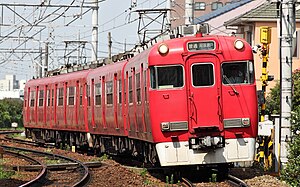| This article includes a list of general references, but it lacks sufficient corresponding inline citations. Please help to improve this article by introducing more precise citations. (November 2024) (Learn how and when to remove this message) |
| Meitetsu 6600 series | |
|---|---|
 Meitetsu 6600 series Meitetsu 6600 series | |
| In service | 1978–2013 |
| Manufacturer | Nippon Sharyo |
| Constructed | 1978 |
| Number built | 12 vehicles (6 sets) |
| Number in service | None |
| Operators | Nagoya Railroad |
| Lines served | Seto Line |
| Specifications | |
| Doors | 3 per side |
| Electric system(s) | 1,500 V DC |
| Current collector(s) | Overhead catenary |
| Safety system(s) | Meitetsu ATS |
| Track gauge | 1,067 mm (3 ft 6 in) |
The Meitetsu 6600 series (名鉄6600系) was a commuter electric multiple unit type operated by Nagoya Railroad (Meitetsu) on Seto Line services in Japan from 1978 to 2013.
Background
In the plan for subway constructions by Nagoya, the Seto Line was intended to have thorough service with the subway from Ozone Station. This plan was scrapped by the city after the construction plan was being shaped. However, Meitetsu made an agreement with the city in 1971 to connect Seto Line with Sakai Station. Because of this, the overhead voltage of the line was raised to 1,500V, and a new underground route was constructed for the urban areas of the line. The construction started in 1978. For the rolling stock after the construction, Meitetsu 3780 series was transferred to the line for express services, but fast acceleration was demanded for rolling stocks for local services to run through the line without waiting on sidetracks between express services. Meitetsu procured six 2-car sets based on the 6000 series design used on Nagoya Main Line services.
History
The fleet entered revenue service in 1978. In 1988, the fleet was retrofitted with longitudinal seating and air conditioning to cope with increase capacity on the Seto Line (the sets were originally built with transverse seating).
Following the introduction of the 4000 series on the Seto Line, the 6600 series fleet was retired by 3 March 2013. By 15 March, all 6600 series sets had been scrapped.
References
- "OpenId transaction in progress". plus.chunichi.co.jp. Retrieved 28 April 2024.
- ^ 大手私鉄の 多数派系列ガイド 7 名鉄6000・6500・6600・6800系 [Major private railway majority stock type guide no. 7: Meitetsu 6000, 6500, 6600, and 6800 series]. Japan Railfan Magazine (in Japanese). Vol. 40, no. 470. Koyusha Co., Ltd. June 2000. pp. 60–71.
- 名鉄6600系が,さよなら運転 [Meitetsu 6600 series says 'sayonara']. Japan Railfan Magazine Online (in Japanese). Japan: Koyusha. 4 March 2013. Retrieved 12 July 2024.
- "Post". Japan Railfan Magazine (in Japanese). Vol. 53, no. 626. Koyusha Co., Ltd. June 2013. pp. 146–162.
- Eiichi Aoki (1986). "History of Nagoya Railways"
- 清水武「名古屋鉄道の輸送・運転業務に携わって」『鉄道ピクトリアル』第771号、電気車研究会、January 2006、124-131p.
| Meitetsu rolling stock | ||
|---|---|---|
| Limited express |  | |
| Commuter | ||
| Withdrawn | ||
| Electric locomotives | ||
This Japanese rail transport related article is a stub. You can help Misplaced Pages by expanding it. |